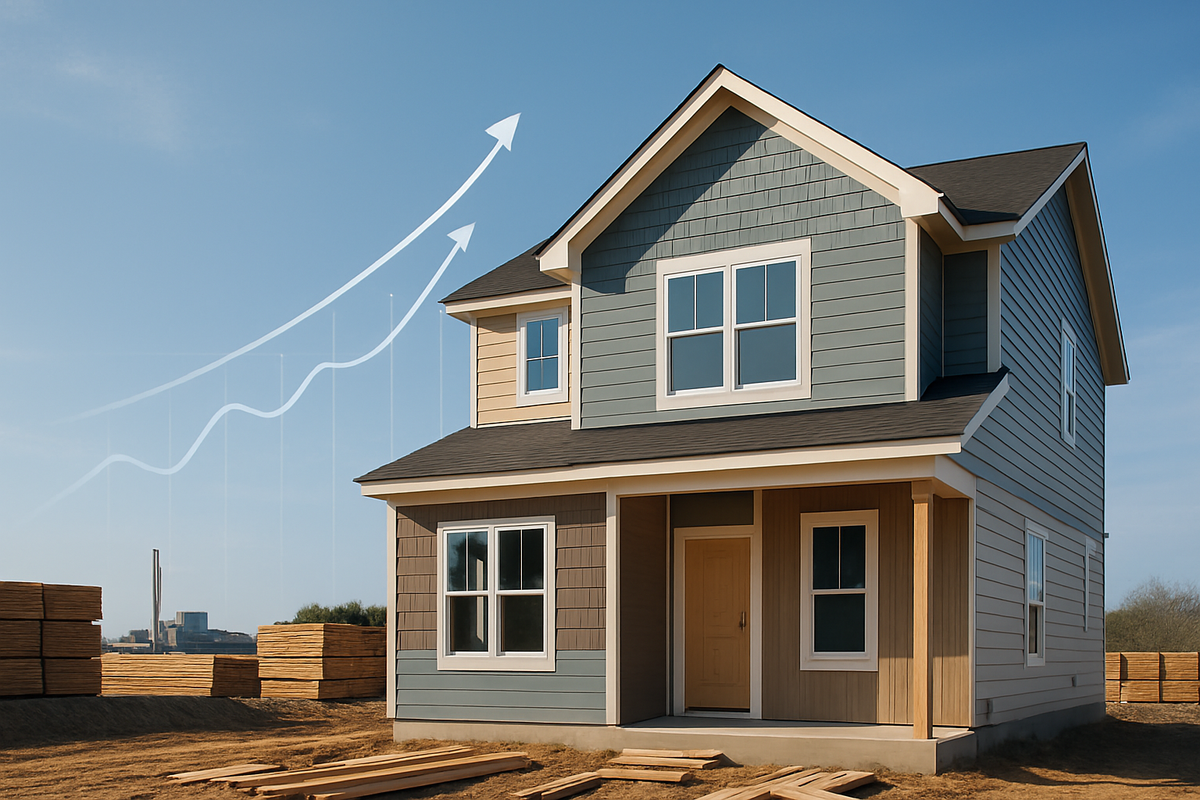
As of October 17, 2025, Louisiana Pacific Corporation (NYSE: LPX), a prominent player in the building materials sector, stands at a pivotal juncture. The company's long-term growth potential, particularly the ambitious prospect of its stock doubling within the next five years, hinges significantly on its strategic pivot towards high-margin siding products and the unpredictable, yet potentially rebounding, wood and timber commodity markets. While LPX's innovative Siding Solutions segment demonstrates robust growth and promises a more stable revenue stream, the persistent volatility and challenges within the Oriented Strand Board (OSB) market, coupled with new trade tariffs, present a complex landscape for investors to navigate.
The immediate implications for LPX and the broader market are a mix of cautious optimism and heightened uncertainty. The residential construction sector, a critical driver of demand for wood products, is showing signs of a potential rebound, fueled by anticipated falling mortgage rates in 2026 and significant pent-up demand for new homes. However, recently enacted US Section 232 tariffs on imported softwood lumber, effective October 14, 2025, are already exerting upward pressure on lumber prices, threatening to increase construction costs and potentially dampen the recovery's pace.
Navigating the Crosscurrents: LPX's Performance and Market Dynamics
Louisiana Pacific's financial performance in the second quarter of 2025 (ending June 30, 2025) vividly illustrates the company's dual nature. While consolidated net sales decreased by $60 million year-over-year to $755 million, this figure masks a stark contrast between its core segments. The Siding net sales segment soared by 11% to a record $460 million, achieving unprecedented sales volume, revenue, and EBITDA. This stellar performance underscores the success of LPX's strategic focus on its SmartSide and ExpertFinish products, which are gaining traction for their durability, energy efficiency, and aesthetic appeal.
Conversely, the OSB net sales segment experienced a significant decline of $101 million, plummeting to $250 million. This weakness in OSB, a more commoditized product, directly contributed to a substantial drop in net income, which fell by $106 million year-over-year to $54 million. The timeline leading up to this moment has been characterized by persistent multi-year low commodity prices in OSB, cautious sawmill operations, and underinvestment in domestic timber production, all contributing to supply tightness. The recent imposition of a 10% duty on imported softwood lumber, with higher levies on finished wood products, by the US government on October 14, 2025, further complicates the supply-demand equation, raising concerns among homebuilders and consumers about escalating material costs. Key players in this scenario include Louisiana Pacific (NYSE: LPX), the broader construction industry, major homebuilders like Lennar (NYSE: LEN) (with whom LPX has a strategic partnership), and government bodies whose trade policies are now directly impacting market prices. Initial market reactions have seen lumber prices rise to $633.12 USD per 1000 board feet as of October 17, 2025, a 10.40% increase over the past month, with forecasts suggesting continued upward pressure.
Corporate Fortunes: Winners, Losers, and Strategic Shifts
For Louisiana Pacific (NYSE: LPX), its robust Siding Solutions segment is undeniably the primary engine for future growth. The company's SmartSide and ExpertFinish products are tapping into a strong demand for durable, low-maintenance, and aesthetically pleasing exterior building materials. LPX anticipates above-market volume growth in its SmartSide business, driven by new product developments and enhanced brand visibility. The strong 20% year-over-year growth in ExpertFinish sales, bolstered by its partnership with Lennar, positions LPX favorably against competitors heavily reliant on more volatile commodity products. This strategic pivot allows LPX to command higher margins and offers a degree of insulation from the wild swings of raw timber and OSB prices.
However, the challenging OSB market remains a significant headwind. While the industry is expected to maintain supply discipline and tight inventory levels into 2025, the multi-year low commodity prices directly impact LPX's profitability in this segment. Companies like LPX that have diversified into higher-value, specialized products are better positioned to weather these storms. In contrast, producers focused solely on commodity OSB or raw timber extraction might find their margins increasingly squeezed by fluctuating prices and rising input costs, particularly with the new tariffs. Homebuilders and contractors, facing elevated lumber prices due to tariffs and constrained supply, are likely to see increased material costs, which could be passed on to consumers, potentially affecting housing affordability and demand.
Broader Implications: Trends, Tariffs, and the Housing Horizon
This confluence of LPX's strategic evolution and the volatile commodity markets fits into several broader industry trends. The housing market, after a period of contraction due to high interest rates, is showing signs of a potential revival. Projections for US housing starts indicate a 4% increase in 2025, with single-family starts reaching 1.14 million units, and further growth anticipated in 2026. This recovery, alongside significant pent-up demand for new homes and a projected increase in repair and remodeling expenditures, bodes well for overall demand for wood products. However, the industry is also witnessing a growing preference for resilient and sustainable building materials, a trend that LPX's Siding products are well-positioned to capitalize on.
The regulatory landscape, particularly the new US Section 232 tariffs on imported softwood lumber and existing elevated duties on Canadian lumber (expected to double to 30% by summer 2025), represents a significant policy implication. These tariffs are designed to protect domestic producers but inevitably lead to higher prices for consumers and increased volatility in the market. The ripple effects extend across the supply chain, impacting not only lumber producers but also distributors, builders, and ultimately, homebuyers. Historically, tariffs have often led to price distortions and trade disputes, creating an environment of uncertainty that can deter investment and slow construction activity. This scenario echoes past periods of trade protectionism in the timber industry, where domestic supply struggled to meet demand, leading to price spikes.
The Path Ahead: Scenarios and Strategic Responses
Looking ahead, the short-term outlook for the wood and timber commodity markets suggests continued price volatility, largely influenced by the new tariffs and ongoing supply constraints. However, the long-term possibilities are more optimistic, particularly for 2026, when falling mortgage rates are expected to significantly stimulate new home demand. For Louisiana Pacific (NYSE: LPX), the continued execution of its Siding Solutions strategy will be paramount. The company's projection of $1.7 billion in Siding net sales and $430 million in Siding Adjusted EBITDA for the full year 2025 indicates a strong commitment to this segment.
Potential strategic pivots for LPX include further investments in Siding production capacity, continued product innovation to meet evolving market demands for sustainability and design, and operational efficiencies to mitigate rising input costs. Market opportunities may emerge from the growing demand for durable and energy-efficient building materials, especially in the repair and remodeling sector. Challenges will include managing the persistent weakness in the OSB market, navigating complex trade policies, and addressing potential labor shortages in the construction industry. Potential scenarios range from a robust housing recovery boosting all of LPX's segments, leading to significant stock appreciation, to a more subdued recovery where the Siding segment alone must carry the growth, making the "doubling in 5 years" target more challenging.
Conclusion: A Balancing Act for Louisiana Pacific
In summary, Louisiana Pacific Corporation (NYSE: LPX) is engaged in a critical balancing act. Its strong and growing Siding Solutions segment provides a compelling narrative for long-term growth and a degree of resilience against market fluctuations. However, the company's exposure to the volatile OSB commodity market, now further complicated by new US tariffs on imported lumber, introduces an element of uncertainty. The market moving forward is characterized by cautious optimism for the housing sector, with anticipated lower mortgage rates in 2026 expected to unlock significant pent-up demand. Yet, the tariff-induced price floor on lumber will likely keep construction costs elevated.
Whether Louisiana Pacific's stock can double in the next five years hinges on several key factors: the sustained, above-market growth of its Siding segment, a eventual recovery in OSB prices, and a robust, consistent rebound in the broader residential housing market. Investors should closely watch housing starts data, trends in mortgage rates, lumber futures prices, and, critically, LPX's quarterly performance in its Siding segment. The company's ability to continue its strategic shift towards higher-value products while adeptly managing its commodity exposure will be the ultimate determinant of its long-term success and stock performance.
This content is intended for informational purposes only and is not financial advice





